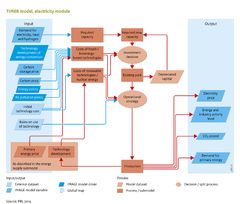Energy conversion/Description: Difference between revisions
Jump to navigation
Jump to search
No edit summary |
No edit summary |
||
| Line 35: | Line 35: | ||
The additional system integration costs relate to | The additional system integration costs relate to | ||
# | # Discarded electricity in cases where production exceeds demand and the overcapacity cannot be used within the system; | ||
# | # Back-up capacity; | ||
# | # Additional required spinning reserve; | ||
The two last items are needed to avoid loss of power if the supply of wind or solar power suddenly drops, enabling a power scale up in a relatively short time, in power stations operating below maximum capacity ([[Hoogwijk, 2004]]). | The two last items are needed to avoid loss of power if the supply of wind or solar power suddenly drops, enabling a power scale up in a relatively short time, in power stations operating below maximum capacity ([[Hoogwijk, 2004]]). | ||
*To determine discarded electricity, the model makes a comparison between 10 different points on the load-demand curve, at the overlap between demand and supply. For both wind and solar power, a typical load–supply curve is assumed (see [[Hoogwijk, 2004]]). If supply exceeds demand, the overcapacity in electricity is assumed to be discarded, resulting in higher production costs. | *To determine discarded electricity, the model makes a comparison between 10 different points on the load-demand curve, at the overlap between demand and supply. For both wind and solar power, a typical load–supply curve is assumed (see [[Hoogwijk, 2004]]). If supply exceeds demand, the overcapacity in electricity is assumed to be discarded, resulting in higher production costs. | ||
Revision as of 15:12, 9 December 2013
Parts of Energy conversion/Description
| Component is implemented in: |
|
| Related IMAGE components |
| Projects/Applications |
| Models/Databases |
| Key publications |
| References |
